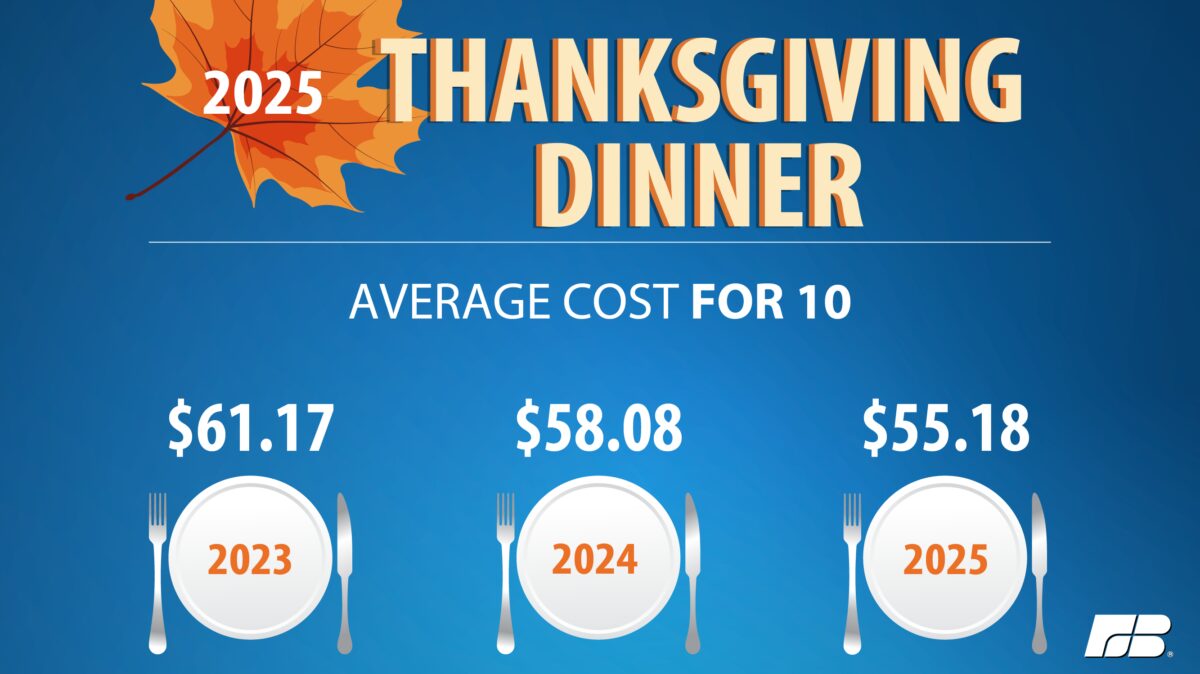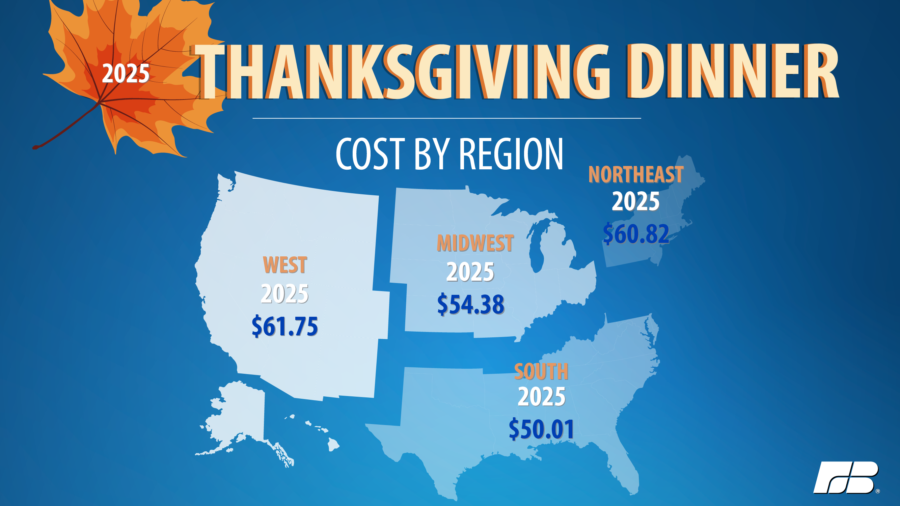Thanksgiving Dinner Cost Analysis: Moderate Decline
TOPICS
Thanksgiving Survey
Samantha Ayoub
Economist
Faith Parum, Ph.D.
Economist
The 40th annual American Farm Bureau Federation (AFBF) Thanksgiving dinner survey finds that a table of classic dishes for 10 people will cost $55.18, down 5% from last year, but still higher than four years ago. Prices of several of the items reflect some of the struggles of farm and ranch families working to stock the grocery store shelves.
The AFBF Thanksgiving Grocery Basket Tradition
For one week leading up to Thanksgiving each year, volunteer shoppers from all 50 states and Puerto Rico visit their local grocery store (or local store’s website) to survey the prices of items used in a classic Thanksgiving feast. Since 1986, these volunteers have reported their local prices for turkey, cubed stuffing, sweet potatoes, dinner rolls, frozen peas, fresh cranberries, celery, carrots, pumpkin pie mix and crusts, whipping cream and whole milk. While many families put their own spin on this traditional dinner, the survey captures many key ingredients in American homes this holiday season.
The classic Thanksgiving dinner grocery bill is a mixed bag of savings and squeezes. Four of the items dropped in price this year – the main turkey dish, cubed stuffing, fresh cranberries and dinner rolls. However, five items – sweet potatoes, frozen green peas, a vegetable tray of carrots and celery, whole milk and whipping cream – rose in price. Pumpkin pie mix and pie shells remained virtually unchanged from 2024.
Prices for ham, Russet potatoes and frozen green beans were added to the survey in 2018 to reflect a wider variety of Thanksgiving favorites. When including the additional items, the meal cost rises to $77.09, or $7.71 per person. The updated Thanksgiving dinner is virtually unchanged from last year – only 28 cents cheaper than 2024 – due to increases in all three additional ingredients.
Turkey No Longer Tops the Bill
As the main dish, turkey is often the biggest ticket item. Over the span of the AFBF Thanksgiving survey, turkey has accounted for an average of 43% of the total dinner cost. However, this year, a 16-pound turkey only accounts for 39% of the cost of a 10-person Thanksgiving dinner. This is turkey’s lowest share since 2000.
This drop in turkey’s cost impact comes from both falling turkey prices and rising costs of sides. A 16-pound turkey will cost an average of $21.50, down 16% from 2024. While fresh turkey prices continue to rise as the poultry sector fights highly pathogenic avian influenza (HPAI), prices for frozen turkeys – the most commonly used for Thanksgiving dinner – continue to fall. On top of this, demand for turkey continues to drop outside of Thanksgiving with the average American consuming only 13 pounds of turkey per year, nearly 3 pounds less than six years ago.
Sides Weigh Heavier on the Receipt
Though overall Thanksgiving meal costs are down this year, side dishes are up in terms of the share of the total basket. Price increases for fresh produce and key baking ingredients reflect higher costs throughout the supply chain. Farmers who grow the fruits, vegetables and potatoes for many Thanksgiving staples continue to face elevated expenses for fertilizer, fuel, machinery, labor and land, which tightens already narrow margins and limits production capacity.
Items like fresh vegetables and sweet potatoes posted some of the most notable increases. A veggie tray is up more than 61% and sweet potatoes are up 37%. Natural disasters contributed to these higher costs. North Carolina, which produces more than half of the nation’s sweet potatoes, experienced hurricane damage that reduced yields and tightened supplies ahead of the holiday. Fresh produce prices are also highly volatile. Even modest disruptions related to weather, labor shortages, transportation delays or regional production setbacks can translate quickly into short-term price spikes at retail.
High labor costs and worker shortages are a major driver of produce costs. Fruits and vegetables rely heavily on manual labor for planting, harvesting, grading and packing, with labor expenses making up nearly half of total production expenses for these industries. Persistent labor shortages and higher wage requirements have increased production expenses for growers, and these higher on-farm costs eventually factor into grocery store prices. It is important to note that items like fresh vegetables and potatoes typically start from a low price point. As a result, even small increases in per-pound or per-unit costs can generate large year-to-year percentage changes.
Several items moved lower in price this year and helped pull down the overall cost of the meal. Dinner rolls are down 14.6%, stuffing is down 9% and cranberries are down 2.8%. Even so, stronger price increases among produce-heavy side dishes kept these items at the center of the overall cost story.
Dressing or Stuffing? Regional Differences Extend to Pricing
Thanksgiving staples and even what people call them, are not the only things that vary across the United States. Regional price differences are notable again this year. For those celebrating in the West, the classic Thanksgiving dinner for a party of 10 costs $61.75, the highest of any region and about 12% more than the national average. Families in the Northeast will also pay more than the national average with their classic meal coming in at $60.82. The South has the most affordable holiday meal at $50.01, followed by the Midwest at $54.38.
A similar pattern emerges when looking at the updated Thanksgiving basket, which includes ham, Russet potatoes and green beans. The South once again has the lowest total at $71.20, followed by the Midwest at $76.33. The Northeast and the West both jumped in cost, at $82.97 and $84.97, respectively. The West again stands apart at more than a dollar per person higher than the other regions.
Give Thanks to the Farmers
Farmers and ranchers are struggling. Crop prices have fallen again while fuel, fertilizer, labor and machinery costs continue to climb, leaving many operations below breakeven. Weather challenges, including drought, flooding and hurricane damage, added further strain, and weaker export demand continues to pressure income. This combination has contributed to a poor farm economy marked by tight margins and rising financial stress. As producers navigate another uncertain year, effective support remains essential to keeping America’s food supply stable, affordable and secure.
Conclusion
According to AFBF’s national Thanksgiving survey, this year’s meal is expected to cost consumers about 5% less than last year. Though this is the third straight annual decline, consumers have not fully recovered from the sharp increases that pushed the classic dinner to a record high in 2022. These consumer savings come as many farmers enter 2026 facing a poor farm economy marked by falling crop prices, persistently high input costs, and lingering weather and disaster losses. Fresh produce prices are especially sensitive to these pressures, with growers navigating continued labor challenges and ongoing supply-chain disruptions. Farmers carry much of the food system’s risk to keep groceries plentiful and affordable, and when conditions tighten, timely and effective support remains critical for helping them stay in business and maintaining a secure, stable food supply.
Top Issues
VIEW ALL


